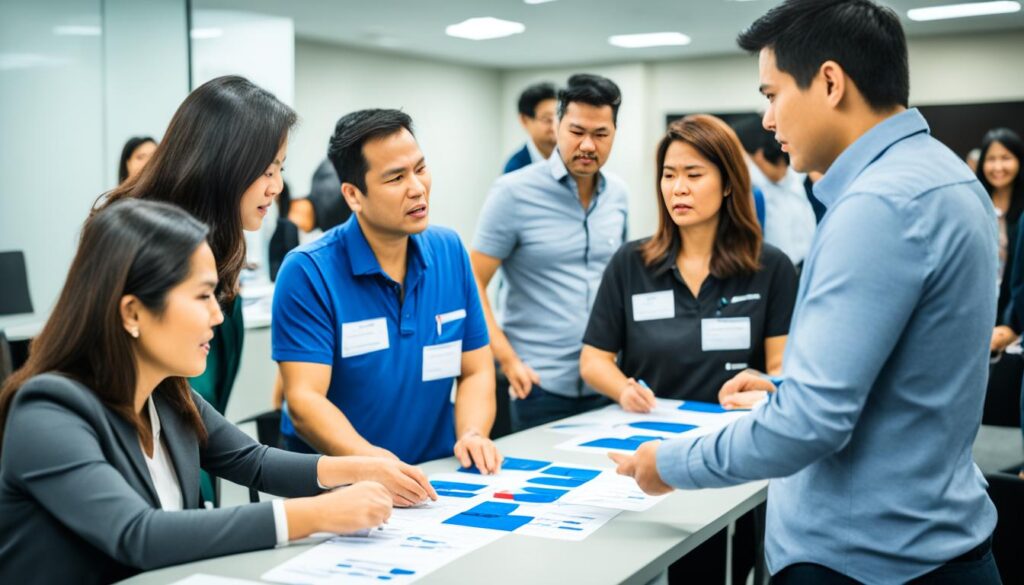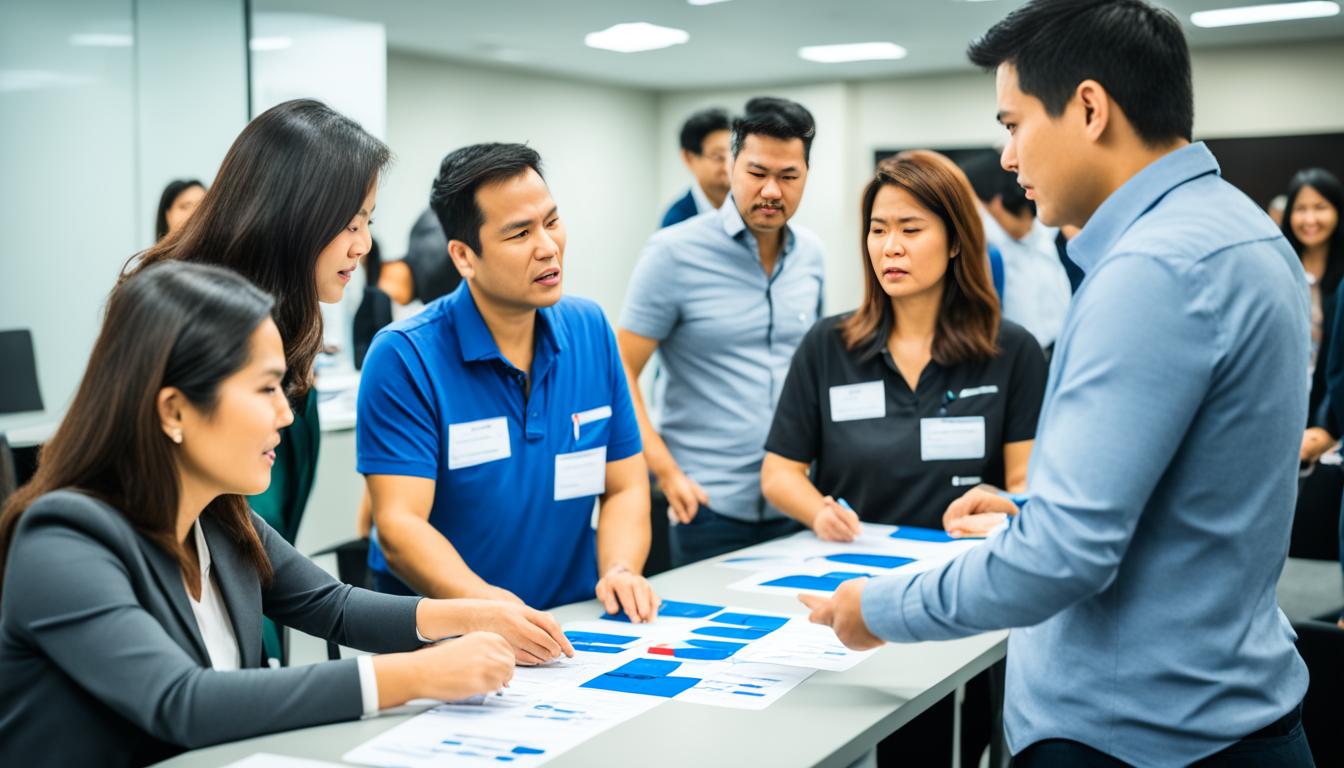Have you ever wondered about the difference between training and development? While these terms are often used interchangeably, they actually have distinct purposes, focuses, and outcomes. Understanding these key differences can help organizations effectively enhance employee skills and promote career growth. In this article, we will explore the core concepts of training and development, dig deeper into their differences, examine their objectives in the workplace, analyze their impact on organizational success, discuss methods and approaches used by companies in the Philippines, and conclude with key takeaways.

Key Takeaways:
- Training and development have distinct purposes and focuses in employee growth.
- Training is focused on skill enhancement for job-specific tasks, while development aims for long-term career growth.
- Both training and development are crucial for organizational success.
- Companies in the Philippines implement various methods and approaches to optimize training and development initiatives.
- By understanding the differences and leveraging the benefits of both training and development, organizations can drive individual and collective success.
Understanding the Core Concepts of Training and Development
Defining Employee Training: A Focus on Skill Enhancement
Employee training is a process aimed at enhancing the skills, knowledge, and competencies of individuals or specific departments within an organization. Its primary objective is to improve job performance, productivity, and the ability to perform tasks effectively. Through structured and organized approaches such as workshops, online modules, and practice exercises, training equips employees with the necessary skills to excel in their current roles.
Defining Employee Development: A Focus on Career Growth
Employee development, on the other hand, encompasses a more holistic process that builds upon pre-existing skills, knowledge, and experiences. It aims to promote personal and professional growth, prepare individuals for future opportunities, and enhance their overall capabilities. Development activities go beyond job-specific skills and may include mentoring, coaching, leadership programs, and career planning workshops. By investing in employee development, organizations nurture talent and foster an environment conducive to long-term career growth.
Digging Deeper into the Difference Between Training and Development
While training and development share the common goal of enhancing employee skills, there are several fundamental differences between the two. Training focuses on improving job performance and productivity by providing employees with the specific knowledge and skills necessary to perform their current role effectively. It is primarily job-oriented and aims to address immediate skill gaps. Development, on the other hand, has a broader scope and focuses on long-term growth and career advancement. It encompasses activities that enhance not only technical skills but also leadership abilities, problem-solving capabilities, and adaptability to change. Development is oriented towards career growth and preparing employees for future roles and responsibilities within the organization.

As seen in the image above, training and development have distinct paths and outcomes. Training is a focused process, designed to fill specific skill gaps and improve job performance in the short term. Development, on the other hand, stretches beyond the immediate needs of the job, aiming to nurture employees’ overall growth and prepare them for future career opportunities.
While training is like sharpening a specific tool, development is like expanding one’s entire toolkit.
Training equips employees with the necessary knowledge and abilities to perform their current role effectively. It provides a structured and targeted approach to address immediate skill gaps, ensuring employees have the technical proficiency required for their job responsibilities.
Development, however, broadens employees’ capabilities beyond their current role. It focuses on cultivating leadership skills, problem-solving abilities, and adaptability to change, preparing employees for future positions and responsibilities within the organization. Development activities may include mentoring, coaching, leadership programs, and career planning workshops, all of which contribute to employees’ holistic growth and long-term career advancement.
By understanding the distinction between training and development, organizations can design comprehensive talent development strategies that cater to both immediate needs and long-term growth. By investing in a balanced combination of training and development initiatives, companies can foster employee engagement, enhance performance, and create a pool of skilled and adaptable professionals ready to take on future challenges.
| Training | Development |
|---|---|
| Focuses on current job performance | Focuses on long-term career growth |
| Addreses immediate skill gaps | Enhances holistic skills |
| Job-oriented | Future-oriented |
| Improves specific technical competencies | Enhances leadership and problem-solving abilities |
| Short-term impact | Long-term impact |
Exploring the Objectives of Training and Development in the Workplace
Objective-Driven Training for Tactical Skill-Building
The objectives of training in the workplace are centered around improving job performance and equipping employees with the necessary skills and knowledge to excel in their current roles. The primary objective of training is tactical skill-building, which involves enhancing technical competencies, improving efficiency, and increasing overall productivity. By providing targeted training programs, companies aim to bridge skill gaps and empower employees to perform their tasks effectively.

Training programs are carefully designed to address specific areas of improvement, whether it’s learning new software applications, honing customer service skills, or strengthening sales techniques. These programs can be delivered through various methods such as workshops, online modules, simulations, or on-the-job training. The focus is to foster hands-on learning experiences that enable employees to acquire practical skills and apply them immediately in their work environment.
By investing in objective-driven training, organizations can enhance the capabilities of their workforce, resulting in increased productivity, improved efficiency, and higher job satisfaction. Employees feel more confident and competent in their roles, leading to better overall performance and organizational success.
Strategic Development Goals for Long-Term Career Evolution
Development, on the other hand, focuses on strategic objectives that contribute to long-term career evolution. It goes beyond the immediate job requirements and aims to cultivate a broader set of skills and competencies that can prepare employees for future roles and responsibilities within the organization.
Development objectives include nurturing leadership potential, fostering adaptability, expanding knowledge across different functions, and facilitating career progression. Companies invest in development programs to support employees’ personal and professional growth, enabling them to take on more senior positions and leadership roles in the future.
“Investing in the long-term career development of employees helps organizations build a pipeline of talented and capable individuals who can contribute to their future success.”
Development initiatives often involve activities such as mentoring, coaching, job rotations, leadership programs, and career planning workshops. These programs provide employees with guidance, feedback, and opportunities to acquire new skills and perspectives. By aligning individual development goals with organizational needs, companies can create a thriving learning culture that fosters continuous growth and empowers employees to reach their full potential.
The strategic goals of development not only benefit individual employees but also contribute to the overall success of the organization. A well-developed workforce possesses the necessary knowledge, skills, and abilities to adapt to changing business environments, tackle new challenges, and drive innovation.
Impact and Importance of Training and Development in Organizational Success
Training and development are crucial factors that contribute significantly to the overall success of an organization. These processes play a vital role in enhancing employee performance, increasing productivity, and ensuring job satisfaction. Well-designed and implemented training programs enable employees to acquire the necessary skills and knowledge to carry out their responsibilities effectively and efficiently.
On the other hand, development programs are instrumental in talent retention, employee engagement, and succession planning. They foster a culture of continuous learning and growth within the organization. Furthermore, development initiatives promote internal advancement opportunities, allowing employees to progress in their careers and take on higher-level roles and responsibilities.

In today’s dynamic business environment, the impact and importance of training and development cannot be overstated. Organizations that invest in their employees’ growth and development are more likely to thrive and achieve their goals. These initiatives create a motivated and skilled workforce, capable of adapting to changes and driving innovation within the organization.
Furthermore, training and development programs contribute to employee satisfaction and engagement. When employees feel supported in their professional development, they are more likely to be committed to their work and demonstrate higher levels of productivity. This, in turn, leads to improved organizational performance and success.
In sum, comprehensive training and development programs are critical components of an organization’s strategy for success. They enhance employee skills, nurture talent, and create a culture of continuous learning. By investing in these initiatives, companies in the Philippines can build a competitive advantage, adapt to evolving business landscapes, and achieve long-term organizational success.
Methods and Approaches: How Companies in the Philippines Implement Training and Development
Companies in the Philippines employ various methods and approaches when it comes to training and development. These strategies are designed to enhance employee skills, foster growth, and align individual goals with organizational objectives. Let’s explore some key methods and approaches used in the Philippines:
The Role of Technology in Employee Training
Technology plays a crucial role in employee training initiatives in the Philippines. Organizations leverage online platforms, e-learning modules, and virtual simulations to deliver flexible and interactive training programs. By utilizing technology, companies are able to provide employees with anytime, anywhere access to training materials. This approach allows for personalized learning experiences and encourages self-paced development. Adopting technology in employee training also facilitates knowledge retention and ensures that professionals stay updated with the latest industry trends and practices.
Mentorship and Coaching as Pillars of Employee Development
Mentorship and coaching programs are highly valued in the Philippines as effective methods for employee development. These initiatives provide employees with valuable guidance, support, and opportunities for skill enhancement. Seasoned professionals serve as mentors, sharing their expertise, wisdom, and experiences to help mentees grow and excel in their careers. Coaching programs, on the other hand, focus on providing individualized feedback, goal-setting, and skill-building. The combination of mentorship and coaching creates a conducive environment for continuous learning and professional growth.
Career Planning Workshops Catering to Filipino Professionals
Career planning workshops specifically tailored to the needs of Filipino professionals are a popular approach to training and development. These workshops provide individuals with the tools, resources, and knowledge to navigate their career paths effectively. They help employees identify their strengths, set meaningful goals, and make informed decisions about their professional journeys. Career planning workshops also facilitate networking opportunities, allowing individuals to connect with industry experts and peers, further enhancing their career prospects. By catering to the unique needs of Filipino professionals, these workshops empower individuals to make strategic career choices aligned with their aspirations.

In summary, companies in the Philippines implement various training and development methods and approaches to maximize employee growth and success. Technology-driven training, mentorship and coaching programs, and career planning workshops for Filipino professionals are some of the key strategies employed. By leveraging these methods, organizations create a culture of continuous learning, skill enhancement, and strategic career development. The integration of these approaches fosters individual and collective success, ultimately driving organizational growth and excellence.
Conclusion
In conclusion, training and development are crucial components of employee growth and success in the workplace. While training focuses on immediate skill-building for job-specific tasks, development aims to foster long-term personal and professional growth. Both training and development contribute to improved employee performance, increased job satisfaction, and the ability to adapt to changing business environments, making them essential for organizational success.
Companies in the Philippines understand the importance of training and development and utilize various methods and approaches to optimize these initiatives. Technology-based training, mentorship programs, and career planning workshops are just a few examples of how organizations in the Philippines enhance employee skills and promote career progression.
By understanding the key differences between training and development and leveraging their benefits, organizations can create a culture of continuous learning and drive individual and collective success. It is through these initiatives that employees are equipped with the necessary skills, knowledge, and support to excel in their roles, paving the way for both personal and organizational growth in the dynamic business environment of the Philippines.
FAQ
What is the difference between training and development?
Training focuses on improving job performance and acquiring specific skills for current roles, while development aims to promote long-term growth and prepare individuals for future opportunities.
What is the importance of training and development in the workplace?
Training and development programs enhance employee skills, improve job performance, increase productivity, contribute to career growth, and foster a culture of continuous learning and adaptation.
How do training and development impact organizational success?
Well-executed training programs lead to improved employee performance and job satisfaction, while development initiatives contribute to talent retention, succession planning, and organizational agility.
What are the objectives of training and development?
Training aims to enhance tactical skill-building, technical competencies, efficiency, and productivity. Development focuses on nurturing leadership potential, fostering adaptability, and preparing employees for higher-level positions.
How do companies in the Philippines implement training and development?
Companies in the Philippines leverage technology-based training, mentorship programs, coaching, and career planning workshops tailored to the needs of Filipino professionals to optimize training and development initiatives.

Leave a Reply